The normal-sized ancient humans who first appeared on the island of Flores in Indonesia shrank rapidly and became small ‘Hobbits’, according to a recent discovery of a 700,000-year-old primitive human.
Several fossils – of at least one adult and two juveniles – suggest that the original normal-sized humans who first set foot on the island became smaller and smaller over a surprisingly short period.
A team of scientists from Japan, Australia and Indonesia published details of their study and findings in the prestigious journal Nature (citation below).
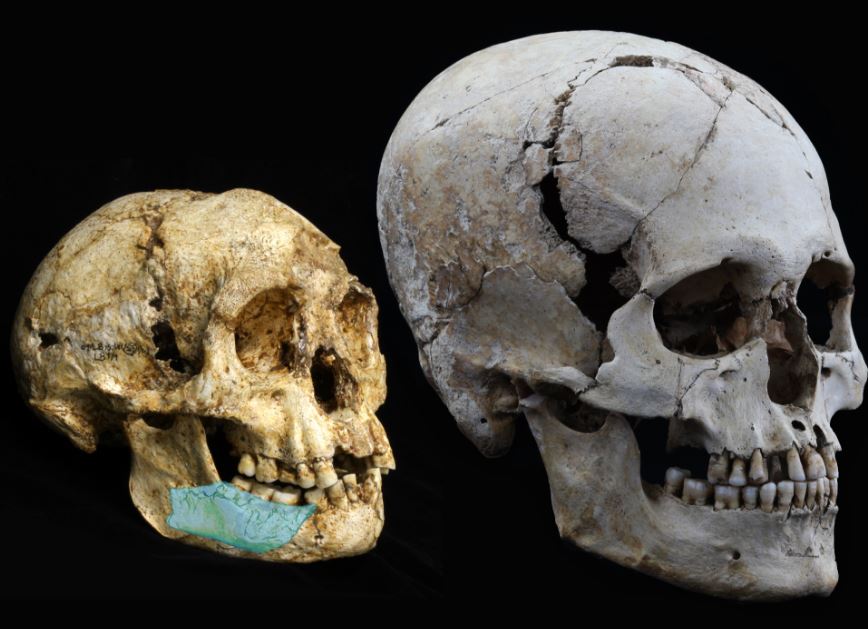 Archaeologists found a piece of lower jaw and some children’s teeth which bring them nearer to determining where the tiny humans of the island of Flores originated from. (Image: griffith.edu.au)
Archaeologists found a piece of lower jaw and some children’s teeth which bring them nearer to determining where the tiny humans of the island of Flores originated from. (Image: griffith.edu.au)
The researchers, from Griffith University and the University of Wollongong, both in Australia, the National Museum of Nature and Science in Tokyo, and the Geology Museum Bandung in Indonesia, wrote about their discovery of ancestors of Homo floresiensis – the island of Flores’ mysterious species of pygmy-like humans.
A partial skeleton of a primitive adult human female was unearthed from Liang Bua, a limestone cave in the west of Flores.
The skeleton – called LB1 – is the most extreme human ever excavated. It was incredibly short, just about one metre tall (slightly more than 3 feet), with a brain smaller than that of a chimp. This extremely small individual existed about 70,000 years ago.
Now the authors explain that fossil remains of hominins of a similar size, excavated at Mata Menge, 70 km east of Liang Bua, are at least 700,000 years old.
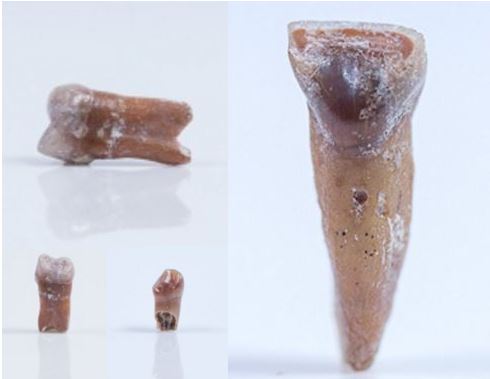 Some of the teeth, including adult and children’s milk teeth, which are estimated to be at least 700,000 years old. These images are not to scale. (Image: Large close-up – uow.edu.au. Other smaller images – uow.edu.au)
Some of the teeth, including adult and children’s milk teeth, which are estimated to be at least 700,000 years old. These images are not to scale. (Image: Large close-up – uow.edu.au. Other smaller images – uow.edu.au)
Archaeologists unearthed a fragment of a hominin lower jaw and a number of isolated teeth in a layer of sandstone which had been deposited next to a lakeside stream about 700,000 years ago.
A breakthrough find
Co-author, Dr. Adam Brumm, an archaeologist and senior research fellow within the Environmental Futures Research Institute at Griffith University, says this new finding is the most spectacular breakthrough yet to help scientists understand the origin of ‘hobbits’.
Dr. Brumm, who first commenced fieldwork at Mata Menge twelve years ago with Indonesian colleagues, and under the leadership of the late Professor Michael John ‘Mike’ Morwood, said:
“We have unearthed fossils from at least three individuals, including two children, along with stone tools that are almost identical to those made by the much younger Homo floresiensis.”
“There is a striking similarity in size and form between the Mata Menge hominins and the Liang Bua hobbit, which is surprising given the former are at least several hundred millennia older.”
“This suggests the Mata Menge individuals belonged to a population of ancient hobbit-like hominins that gave rise to Homo floresiensis. They may even have been a very early form of hobbits, which would mean this species existed for far longer than anyone had anticipated.”
Ever since the hobbit bones were first discovered, researchers have been at a loss to make sense of where Homo floresiensis – a previously unknown species – fits into the human family tree.
Scientists believe that these creatures evolved from an archaic branch of hominins who lived a long time before our own species in Africa emerged about 200,000 years ago. However, there is disagreement among experts regarding which member of the hominin group spawned Flores hobbits.
 Mata Menge excavations. (Image: griffith.edu.au)
Mata Menge excavations. (Image: griffith.edu.au)
Two hypotheses regarding Hobbit origins
The distinctive and unique anatomy of Homo floresiensis has led to two hypotheses:
1. Java Man: some experts suggest that hobbits descended from Java Man, also known as Asian Homo erectus, an early hominin that reached the island of Java west of Flores approximately 1,500,000 years ago – Homo erectus was similar in height to modern humans.
Perhaps a small group of these hominins became stranded on Flores, and reduced in size over time. This would be the first case we know of – of hominins conforming to the ‘Island Rule’ – in which mammals cut off on islands with no predators and limited food became small if they were large (dwarfism) or large is they were small (gigantism).
2. A very ancient precursor: other experts suggest that perhaps Homo floresiensis stems from considerably more ancient precursos, such as Homo habilis, or even an ape-like australopithecine, primitive forerunners of hominins known only from the early fossil record of Africa.
The two hypotheses were put forward, and did not really make much progress for a long time, that is, until the discovery of these latest fossils.
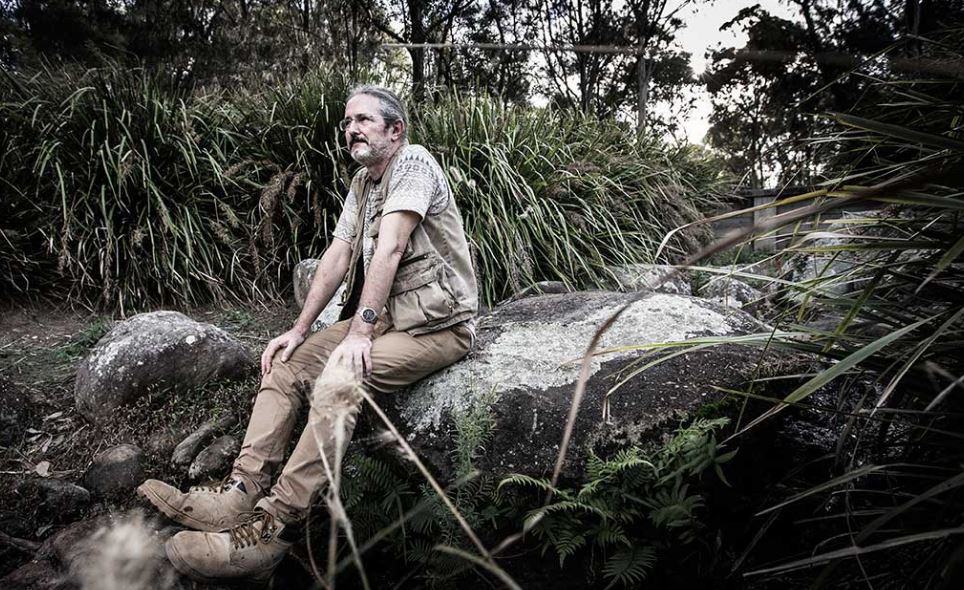 Dr Gerrit ‘Gert’ van den Bergh led the team that excavated the lower right jaw fragment and six teeth. (Image: uow.edu.au)
Dr Gerrit ‘Gert’ van den Bergh led the team that excavated the lower right jaw fragment and six teeth. (Image: uow.edu.au)
Dr. Brumm said:
“While only a handful of fossils has been found at Mata Menge so far, characteristic features of the teeth strongly imply an ancestral relationship with Homo erectus.”
“This lends weight to the theory that the hobbit was a dwarfed version of the famous Java Man, which somehow got marooned on the island. The fact that they were found with fossils of extinct pygmy elephants (Stegodon) and giant rats also supports the idea of an isolated group of Homo erectus undergoing a dramatic evolutionary change owing to the Island Rule.”
More specimens needed
Dr. Brumm adds, however, that the mystery of the hobbit’s origins has not yet been conclusively resolved – we need more complete hominin fossils.
Dr. Brumm explained:
“We were expecting a simple answer. We didn’t get one: no one thought the ancestor of the hobbit would itself have looked like a hobbit. I do think Homo floresiensis was a dwarfed Homo erectus, but identifying the true ancestor requires more fossil evidence.”
The authors believe more skeletal remains will be found, given that the fossils unearthed so far at Mata Menge were of multiple individuals. The researchers are currently looking for a financial backer so that they may expand the scale of excavations at this site and other promising fossil locations on the island.
 Dr. Adam Brumm, from Griffith University’s Centre for Human Evolution. (Image: griffith.edu.au)
Dr. Adam Brumm, from Griffith University’s Centre for Human Evolution. (Image: griffith.edu.au)
Dr. Drumm said:
“Mata Menge is a goldmine. I expect that further excavations at this site will eventually yield a hominin skull, which will finally allow us to put a face and a name to the hobbit’s ancestor. Then we will know how this experiment in human evolution got started.”
The team that excavated the lower right jaw fragment and six teeth was led by Dr Gert van den Bergh, from the University of Wollongong’s (UOW) Centre for Archaeological Science. Dr. van den Bergh said:
“Remarkably, these fossils, which include two milk teeth from children, are at least 700,000 year old. This find has important implications for our understanding of early human dispersal and evolution in the region and quashes once and for all any doubters that believe Homo floresiensis was merely a sick modern human (Homo sapiens).”
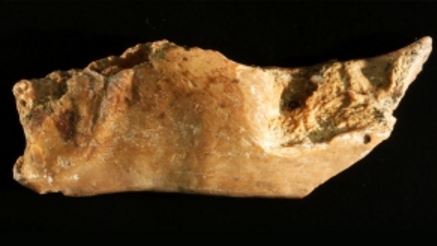 This jaw bone – found on Flores – is from a tiny adult; even smaller than the ‘Hobbit’. (Image: nature.com)
This jaw bone – found on Flores – is from a tiny adult; even smaller than the ‘Hobbit’. (Image: nature.com)
Dr. Yousuke Kaifu, who works at Tokyo’s National Museum of Nature and Science, compared the fossils with an extensive dataset of modern and fossil hominins to identify them. Dr. Kaifu said:
“All the fossils are indisputably hominin and they appear to be remarkably similar to those of Homo floresiensis. The morphology of the fossil teeth also suggests that this human lineage represents a dwarfed descendant of early Homo erectus that somehow got marooned on the island of Flores.”
“What is truly unexpected is that the size of the finds indicates that Homo floresiensis had already obtained its small size by at least 700,000 years ago.”
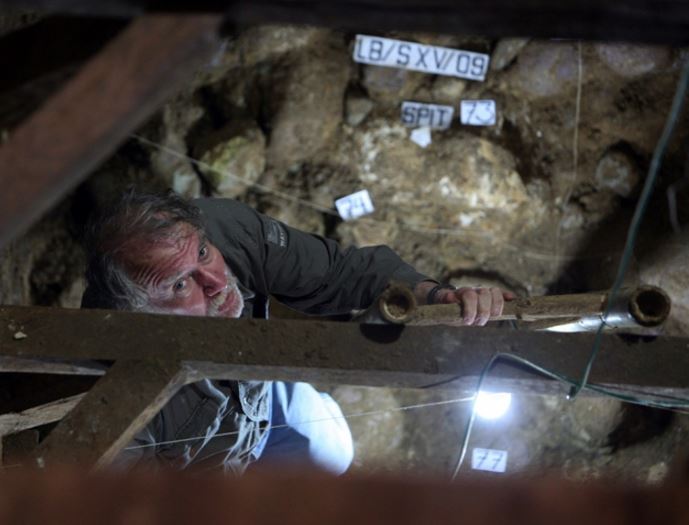 The late rock-art specialist, Professor Mike Morwood (1950-2013) at Liang Bua cave, where his team discovered Homo floresiensis. (Image: nature.com)
The late rock-art specialist, Professor Mike Morwood (1950-2013) at Liang Bua cave, where his team discovered Homo floresiensis. (Image: nature.com)
In an Abstract that describes the main paper in the journal, Dr. Brumm and colleagues wrote:
“The Mata Menge fossils are derived compared with Australopithecus and H. habilis, and so tend to support the view that H. floresiensis is a dwarfed descendent of early Asian H. erectus.”
“Our findings suggest that hominins on Flores had acquired extremely small body size and other morphological traits specific to H. floresiensis at an unexpectedly early time.”
The Mata Menge research was supported by an ARC (Australian Research Council) Discovery grant, and the Geological Survey Institute of Bandung.
Citation: “Homo floresiensis-like fossils from the early Middle Pleistocene of Flores,” Gerrit D. van den Bergh, Yousuke Kaifu, Iwan Kurniawan, Reiko T. Kono, Adam Brumm, Erick Setiyabudi, Fachroel Aziz & Michael J. Morwood. Nature 534, 245–248. DOI: 10.1038/nature17999.
Video – Amazing new finds offer clues to ‘Hobbit’ ancestry
In a spectacular new discovery, scientists have unearthed the fossilised remains of ancient hominins in Indonesia, which appear to be the ancestors of the tiny species of human – Homo floresiensis – affectionately nicknamed the ‘Hobbit’, that stood just over 3 feet (1 metre) tall.
